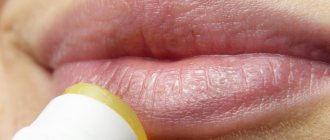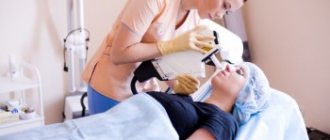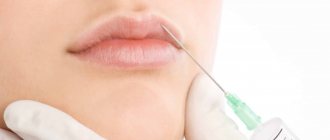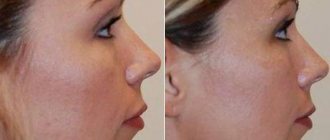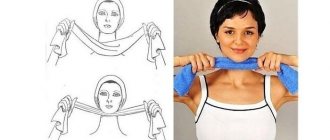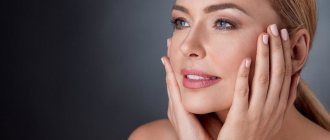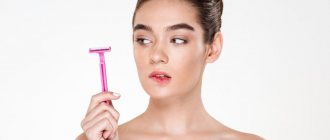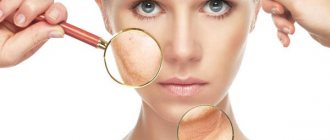Facial asymmetry refers to different distances or angles of inclination of individual parts of the right and left halves in relation to the central plane. Plastic surgeons say that there are no perfectly symmetrical proportions. Visually, only a specialist can determine small deviations in the shape of the oval, nose, and outline of the lips. For some people, distinctive features of appearance are a memorable “highlight”. Not in all cases they need to be eradicated. Treatment of facial asymmetry is required if a person has psychological and aesthetic problems.
Facial asymmetry in the concept of physiognomy
Physiognomy as a science that connects facial expression and its structure with certain character traits and thoughts of a person, attaches great importance to symmetry. Any deviations from the balance of the left and right halves are considered as signs of personality disharmony. Supporters of this trend believe that people with predominantly symmetrical features are distinguished by honesty, and with broken symmetry they have the ability to hide their thoughts and lies.
One of the popular authors of works on physiognomy, Simon Brown, emphasizes that the right half of the face represents the main emotions, personal characteristics, and is associated with the inheritance of creative abilities through the mother. The left side reflects logical thinking and personality, passed down from male relatives.
There are several classic standards for “reading” a face:
- If there is asymmetry in the width of the oval, a shift towards the left half indicates more developed mental abilities (in mathematics, exact sciences, philosophy); if the right side of the skeleton is more developed, then the person is credited with creative professions (art, acting).
- The length of the face is assessed by the shape of the chin - if there is a slant to the right or left, then the balance of the processes of tension and relaxation suffers, this is expressed in unexpected irritability, “outbursts” of anger, and sudden changes in mood.
- Irregularities in the “intellectual zone” (forehead, wrinkles on the bridge of the nose, different shapes and depths of the eyes, raised eyebrows) are considered depending on the degree of deviation. With moderate asymmetry, it imparts confidence to facial features and a desire for a goal; if pronounced, it is recognized as a sign of a contradictory personality.
Modern computer programs make it possible to take into account many deviations from the mirror arrangement of different sides. Physiognomy bases its conclusions on an accurate 3-D description of a personality portrait and psychoanalysis of a specific case.
Facial nerve paralysis: symptoms
Damage to the facial nerve is characterized by the fact that the face is skewed on only one side, and asymmetry of the entire face is observed. This means that the patient has both the lower part of the face affected (the corner of the mouth is drooping, he cannot bare his teeth, the tongue deviates to one side) and the upper part of the face (one eye is closed or the eyelid is drooping).
When diagnosing this pathology, the doctor may resort to the following additional examination methods:
- electromyography - the study of facial muscles by recording the signals that come from them;
- magnetic resonance imaging - visualization of the brain using a tomograph, which will help exclude brain damage (tumor, injury, stroke).
Reasons why facial asymmetry occurs
The physiological norm is considered to be a deviation in the location of parts of the face by 2–3 mm or an angle of up to 5 degrees. If the imbalance is more pronounced, then facial asymmetry is recorded. The causes are divided into 3 groups: congenital, acquired and mixed. In addition, it is important for plastic surgeons to distinguish between static and dynamic asymmetry. The first type is visible in the absence of muscle contractions when the face is at rest. The dynamic type is characterized by manifestation only during actions (smiling, chewing, wrinkling the forehead).
Congenital causes
Anomalies of intrauterine development are influenced by the correct course of the mother's pregnancy, nutritional balance, stress experienced, and genetic mutations. As a result, the formation of the osteochondral skeleton of the fetal face is disrupted, and the muscular system develops unequally. The most significant:
- asymmetrically developed bones of the facial part of the skull;
- sharply reduced (underdeveloped) lower jaw;
- the influence of impaired formation of the articulations of the temporal and lower jaws on the width of the face;
- abnormalities of muscles and connective tissue responsible for facial expressions and eye movements (strabismus).
The development of the child’s bone skeleton continues until adulthood, so subtle changes can be compensated independently. Hereditary predisposition includes an imbalance that arose due to increased plasticity of nasal cartilage and lack of progesterone synthesis during pregnancy.
Acquired reasons
Throughout life, a person encounters various factors that can change the symmetry of the face. These include:
- injuries to the facial bones (especially the nose, jaw);
- inflammatory diseases in the area of the mandibular joints, nasal sinuses, teeth;
- pathology of chewing and facial muscles;
- violation of bite formation;
- improper growth of teeth;
- consequences and signs of neurological pathology;
- general severe diseases accompanied by a decrease in immunity and metabolic disorders.
Injury to the facial skeleton can occur during childbirth due to incorrect presentation of the fetus or careless actions of medical workers. Inflammation of the mandibular joints is caused by a child suffering from mumps, otitis media, and frequent runny nose complicated by sinusitis.
The relationship of neurology to the causes of imbalances
Emotional experiences (joy, interest, crying, fear, grief) are reflected on a person’s face. Each is characterized by a certain “mask”, which is formed by contractions of facial muscles. The signal comes from the cerebral hemispheres along the nerve trunks. Anatomical structures cause the same actions on both sides.
If on the one hand there is a focus of inflammation, a tumor, or traumatic disorders in the path of impulse transmission, then the muscles contract differently. Sensitive endings react with pain, and an adaptation appears in muscle groups that reduces pain. This is reflected in the symmetry of the face. Based on the sign, the neurologist diagnoses the level of damage.
When choosing a method for eliminating asymmetry, cosmetologists and plastic surgeons take into account that the static (morphological) option is often caused by anomalies in the development of the bones of the facial skull, injuries, and the consequences of diseases of the muscular system.
To identify functional changes, the patient is asked to smile, stretch out his lips, and raise his eyebrows. Only with “provocation” are signs of unequal contraction of muscle groups revealed. The pathology is characteristic of neuritis of the facial nerve, the consequences of cerebrovascular accident (stroke).
Among the most common lesions of the nervous system leading to facial asymmetry are:
- injuries to the facial nerve resulting from a bruise or complications of surgery;
- neuropathy of the facial nerve (Bell's palsy);
- consequences of unilateral paralysis (due to significant relaxation of muscle tone on one side and high muscle tone on the other);
- unilateral pain syndrome in the face area;
- a sign of damage to the facial nerve due to a viral disease (herpes);
- myasthenic syndrome.
Neurologists take into account a group of synkinesis. This is an abnormal joint contraction of certain muscles. For example, when the eyelid droops and the forehead wrinkles, the corner of the mouth rises on the same side. A similar dependence is formed with neuritis of the facial nerve due to the connection of the fibers with other impulse pathways. In children, the condition is reflected in the development of speech and the pronunciation of individual sounds.
Diagnosis of causes
Facial asymmetry (the causes and treatment of pathology, as well as the likelihood of correction are determined by a number of diagnostic methods) is amenable to the main diagnostic methods:
- visual inspection;
- measuring facial proportions;
- physical methods;
- blood and urine tests;
- MRI of the skull.
By observing the patient for 2-3 minutes, a neuropathologist or neurologist can formulate a general picture of the pathology based on deviations in motor skills. At this stage, the possibility of facial correction without surgery is determined.
Deviations are measured not only in the zone of symmetry violation, but also in areas where pathology is not observed. Deviations from the axis of symmetry are compared: the lower jaw, temporal bones, brow arches, and the location of the frontal bone. A cosmetologist or plastic surgeon compares deviations with standards for given anatomical features of the skull structure.
Physical methods are used by a neurologist. Using palpation (pressure), the degree of deformation and tension of the facial muscles and facial nerves are determined. Percussion (tapping) makes it possible to diagnose the speed of impulses passing through the facial nerves.
A general blood test is effective at the initial stage of pathology, when the cause is complications of neuralgia and or inflammatory diseases of the face: neuralgia, gingivitis, advanced periodontitis, arthritis, as well as swelling due to indolent allergies. With inflammation, ESR increases.
ESR levels reach 25 with inflammation of bone tissue; no higher than 20 if the process occurs in soft tissues (neuralgia). A biochemical blood test shows the ratio of macroelements to microelements - excess zinc content with low iron leads to fragility of bone tissue in the pathological area, and high calcium provokes hardness and fragility of the bone.
Urinalysis is effective in combination with a biochemical blood test - it is possible to calculate the dynamics of accumulation and excretion of proteins and mineral salts.
MRI is performed if there is a suspicion of disruption of the cerebral hemispheres. This method also allows you to determine the speed of passage of nerve impulses, both in the cerebral cortex and in the facial nerves.
Stages of development of facial asymmetry
The stages of formation of facial asymmetry depend on the degree of dysfunction of the facial nerve responsible for facial expressions. It is proposed to take into account static and dynamic changes:
- I — despite the pain, the motor functions of the facial nerve are not impaired;
- II - when smiling, moderate asymmetry is revealed, closing the eye requires effort;
- III - the signs are clearly expressed, it is impossible to raise an eyebrow, limited mobility or spasm of the facial muscles is detected;
- IV - asymmetry is determined at rest in the form of an incompletely closed eye, sagging of the corner of the mouth;
- V - muscle contraction on the affected side is impossible, but there is no pronounced spasm (contracture);
- VI - the tone drops sharply, movements are completely paralyzed.
Stars with facial asymmetry
If all our celebrities had perfectly symmetrical faces, they would be boring to look at. However, it is doubtful that they would have become famous then. Slight asymmetry adds charm and makes the face special and recognizable.
Look at Meryl Streep: her nose is slightly tilted to the side, as is the oval of her mouth. We see the same thing with Harrison Ford, in addition, his ears are not on the same line. Handsome Jim Morrison had an uneven lip line: on the right they are much thinner.
And even the most famous models in the world - those who have become famous throughout the world - have asymmetrical nuances in their faces, despite their almost perfect appearance.
Just evaluate Cindy Crawford's face: her wonderful smile is far from the mathematical ideal of symmetry. A rather large mole on the lip also adds piquancy.
So you should never strive for a faceless ideal. And it’s better to always remain yourself, correcting only what really interferes with your life and feeling happy. Read this blog - let's learn to enjoy life together!
How to correct facial asymmetry?
The choice of treatment method depends on clarifying the cause of the asymmetry. It is strictly not recommended to use folk remedies. Their use can worsen the situation. Conservative therapy includes facial exercises, means to increase or decrease muscle tone (electrical stimulation). If there is no effect, injection and surgical methods are indicated.
Cosmetologists consider possibilities only after unsuccessful treatment with neurological drugs. To correct the oval of the face, the shape of the nose and lips, use:
Physiotherapeutic treatment of certain muscle groups - in the first 2 weeks of the disease, the anti-inflammatory effect of blue light, magnetic therapy apparatus, ultrasound with “Hydrocortisone” (phonophoresis), and infrared laser waves are suitable. On days 10–14, it is necessary to examine the electrical excitability of the nerve trunk. If it remains reduced or lost, electrical stimulation is prescribed.
The duration of the procedure is 5–7 minutes, 10 manipulations are required per course. Proserina electrophoresis is performed as prescribed by a doctor. To relieve increased tone, paraffin and mud applications are used.
Injections of drugs based on botulinum toxin (Botox, Dysport, Lantox). To equalize symmetry, injections are given on the healthy half of the face to relieve reflex muscle spasm. If the affected muscle groups causing synkinesis or contractures are accurately identified, then the drugs are administered specifically at certain points. With the help of several courses, it is possible to restore symmetry in 4–6 months.
Botox or hyaluronic acid injection
The introduction of fillers with hyaluronic acid - this method allows not only to perform contouring, lift the corner of the mouth, eyelid, but also to normalize blood circulation in the affected area. Injections are carried out along certain lines, a grid or points (multipuncture method). When choosing a drug, the concentration of hyaluronic acid is taken into account.
The patient will have to maintain the effect obtained after 8–12 months, since the medicine is gradually absorbed. To fill the tissue defect and increase the volume, lipofilling with autologous fat tissue is used.
Surgical correction and thread lifting are the only option for severe unilateral deviation of the anatomical structures of the face. Fillers and botulinum toxin do not correct bone abnormalities.
Thread lifting and surgical treatment
If the defect in the arrangement of paired areas of the face is 50 mm or more, surgical techniques can help restore the aesthetic appearance. Thread lifting is carried out by plastic surgeons by introducing special thread-like preparations made of gold, platinum and polymer materials. They fix sagging muscles and eliminate imbalances.
The operation involves correction of bone defects and persistent contractures. It is performed under anesthesia through a micro-incision using endoscopic technique or with open access. Autoplastic materials and endotins are used. To lift the corner of the mouth, part of the skin and muscles is excised, and the shortened stretched ends are sewn together.
Gymnastics for facial asymmetry
In any case, gymnastics and facial massage help improve microcirculation in tissues and stimulate muscle tone. It is especially indicated for impaired functioning of the lower jaw joint, stretching of the surrounding muscles. It is recommended to carry out the exercises daily in a course of 2–3 months, gradually increasing the number of repetitions from 20 to 50. An approximate complex:
- close your eyes and sharply open your eyes as much as possible;
- form your lips into a tube and pronounce the sound “i”;
- with your nose pinched, imitate a deep breath;
- carry out rotational movements with the tongue in one direction and the other;
- alternately contract the corners of the mouth.
Defect elimination methods
The choice of treatment methods largely depends on the cause of pathological changes and the degree of their severity. The most popular of them:
- Specific neurological therapy, consisting of a complex of drugs that improve blood circulation and metabolism in tissues, anti-inflammatory (if necessary), antiplatelet, antioxidant drugs and agents that stimulate regeneration processes.
- Correction of lip asymmetry with hyaluronic acid (contour plastic surgery) or Botox injections.
- Alignment technique by introducing special absorbable biothreads along the contour.
- Surgical methods.
- Physical therapy and manual therapy.
- Methods of complex therapy - a combination of contour plastic surgery with botulinum therapy, a combination of plastic surgery techniques with methods of injection cosmetology and physical therapy.
The asymmetry appeared due to damage to the facial nerve. Treatment method: botulinum therapy with Botox
Fillers
Hyaluronic acid fillers of varying densities are injected with a thin needle into the area of folds and areas of tissue deficiency. This makes it possible to eliminate the disproportion of depth and location visible to the eye, for example, purse-string wrinkles, nasolabial folds, which create the impression of asymmetrical closure line, etc.
Hyaluronic acid preparations make it possible to slightly raise the corners of the mouth, increase the density of the thin upper lip relative to the lower lip, and eliminate disproportion, especially noticeable in the area of their outer thirds.
If in some cases, after lip augmentation, asymmetry appears, which usually happens due to an incorrect technique for introducing filler or incorrect calculation of the volume of its injection, this deficiency can be eliminated after 1-2 weeks or by correction by additional injection of hyaluronic acid on the opposite side of the corresponding area, or by injecting drugs with the enzyme hyaluronidase, which destroys hyaluronic acid (read more about removing dermal fillers from lips in the previous article).
Correction of lip asymmetry by introducing dermal gel based on hyaluronic acid
In addition, the formation of disproportion may be associated with complications in the form of an inflammatory process after filler injections and the formation of granulomas, scars, etc., which can lead to asymmetry. Such defects can only be corrected surgically.
Video: Augmentation and correction of lip asymmetry with fillers
Surgery
In the case of a pronounced violation of symmetry caused by severe congenital pathology, injuries and scar changes, fibromas, papillomas and other benign formations, as well as in case of disproportions that cannot be corrected using the above injection techniques, there is only one, radical, possibility of eliminating the defect - this is correct lip asymmetry surgically. The operations consist of removing benign tumor-like formations or performing plastic surgery (cheiloplasty).
Thus, the indications for cheiloplasty for asymmetry are:
- congenital developmental defects and post-traumatic defects, including scars;
- the need to raise the corners of the mouth to eliminate symmetry and disproportion;
- removal of benign tumors.
- the need to remove biopolymers or biogel introduced earlier.
The main methods of performing surgical plastic surgery are:
- lipofilling - correction using specially processed adipose tissue taken from the patient himself;
- reduction plastic surgery, which consists of making an incision along the contour, excision of scars, fibroids, removal of biopolymer or non-absorbed biogel, followed by the formation of an aesthetic form;
- Corner lift technique used to eliminate the drooping corner(s) of the mouth. For this purpose, small fragments of skin and muscle fibers are excised above the corners, followed by suturing of the incision area, which helps to stretch and lift the tissues of the corresponding area.
Surgical removal of cosmetic lip defects
Complex correction through surgery and targeted administration of botulinum toxin
Physiotherapy
It is often possible to eliminate defects through manual correction, massage and physical therapy. Exercises and manual therapy are used, as a rule, with other methods and have the purpose of:
- eliminating hypertonicity of one group of facial and chewing muscles and increasing the tone of other muscles;
- increasing skin tone and elasticity, reducing the severity of developing wrinkles and folds that deform the corners of the mouth;
- improvement of microcirculation in tissues, their blood supply and delivery of nutrients and oxygen, which, in combination with specific drug therapy prescribed by a neurologist, helps reduce the severity of the inflammatory process and pain syndrome with neuritis of the facial nerve;
- improving the function of the temporomandibular joint;
- the maximum possible correction of the position of the bones and joints of the facial skull and cervical spine.
The combination of other methods of treatment and correction with therapeutic exercises and manual therapy is characterized in many cases by the impact not only on the consequences, but also on the causes that caused the violation of symmetry, as well as the duration and durability of the positive result achieved, the absence of negative effects, safety and painlessness, absence of contraindications and restrictions.
Lip asymmetry - six ways to get “bows”
Asymmetry of the contours of the lips has the same reasons as the rest of the face. But you should pay attention to the dangerous consequences of introducing fillers at home to increase volume. Incorrect calculation of the need for the drug and violation of technology lead to unexpected results.
If asymmetry is associated with individual characteristics, cosmetologists use additional injection of filler on one side or a destructive drug with the enzyme hyaluronidase. Sometimes you have to resort to surgical removal of biogel.
To achieve the effect of “Parisian” lips or a “bow,” fillers with hyaluronic acid are injected into the upper lip. By increasing the volume, one achieves the creation of an O-shape. Usually 1 ml of filler is enough. The technique of administration depends on the original form. Options are possible if the lower lip is thick enough, injections are carried out:
- in the central toe on both sides equally;
- into arcuate elevations;
- in the middle part of the internal mucosa;
- evenly “fan” along the contour;
- while simultaneously raising the corners (a diamond shape is created).
Correction of lip asymmetry does not equally cover the contours on both sides. The amount of filler consumed depends on the damaged shape. If the lower lip is thin, it is chipped at the same time, without affecting the corners of the mouth.
Asymmetry from birth
Occurs during intrauterine development of the fetus due to:
- underdevelopment of the lower jaw;
- abnormal development of the skull bones;
- defects in the development of muscle and/or connective tissue.
Correction methods are selected depending on the cause of the asymmetry, as well as determining its type:
- dynamic (functional) - the facial muscles contract asynchronously, appear during facial expressions and are invisible at rest;
- static (morphological) - differences are noticeable at rest.
Ways to eliminate the problem are selected taking into account the severity of the asymmetry and can be prescribed in the form of:
- physiotherapy;
- injection procedures;
- surgical intervention - for complex manifestations.
Correction with fillers
It allows you to not only hide, but also eliminate uneven contours for a long time - up to 2 years. For slight asymmetry, contour plastic surgery with hyaluronic acid is used. If you need to make a significant lift or a denser lip structure, softlifting is used - 3-D modeling by introducing fillers with different densities to different depths.
Botox
Method of administering botulinum toxin injections to relax muscles. It is used if one side of the face is prone to hypertonicity of muscle tissue.
Massage
Makes muscle and nerve endings work more intensely. Designed to build muscle mass or change its shape in the right places, as a result of which unevenness is smoothed out. It is most effective in combination with hardware therapy - myostimulation, which affects the right places using minor electrical signals. To achieve the desired result, the massage is carried out in a course. The number of sessions is determined by the doctor.
Gymnastics
Minor asymmetry can be corrected with exercise. They should be done regularly, creating an increased load on the side that is lowered down - all exercises done should be doubled in comparison with the more raised side.
Thread lifting
The technique is designed to tighten sagging tissues - reinforcement. During the procedure, special threads are introduced under the skin - non-absorbable, long-term absorption, absorbable, combined.
With their help, a durable frame is created for a long time, which evens out facial features.
If the asymmetry is very pronounced - the deviation is more than 5 cm in total when drawing horizontal lines at eye level, under the nose and in the center of the lips - then only surgical plastic surgery will help. And in case of deformation of the skull bones, orthodontic intervention may be necessary.
